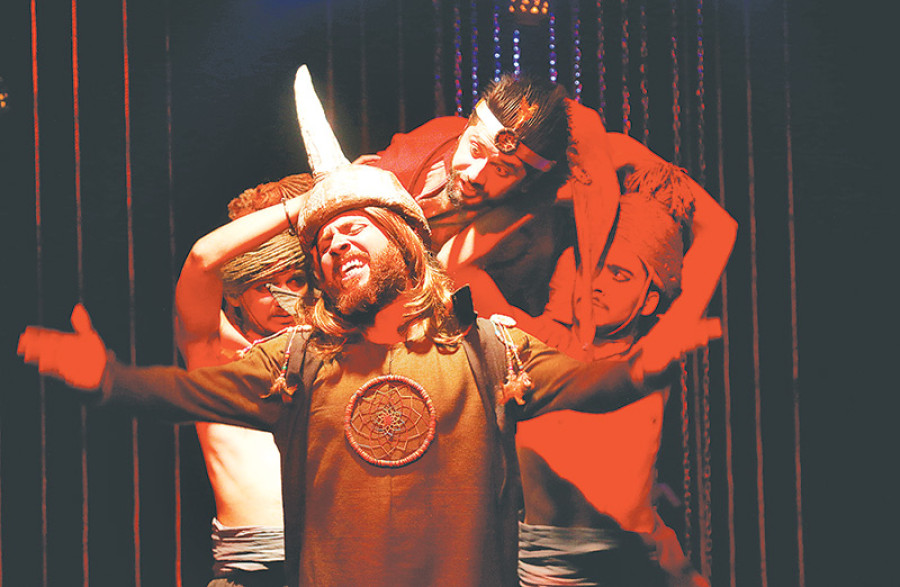Miscellaneous
Tyranny vs reason
Watching the Mandala Theatre’s translation of Sophocles’ classic tragedy Antigone, one is reminded of how, even though the earth keeps rolling for two millennia, even after such technological advancements, so much of the human condition still remains the same.
Timothy Aryal
Watching the Mandala Theatre’s translation of Sophocles’ classic tragedy Antigone, one is reminded of how, even though the earth keeps rolling for two millennia, even after such technological advancements, so much of the human condition still remains the same. Much has been written about the power and timelessness of classic Greek plays, and that one of the most famous of them has been translated to Nepali is a welcome sign, and perhaps it is also timely. The mysoginistic tyrant that Creone is can be found in many avatars in this age too, and that the innocent Antigones continue to suffer. How the ego and the lack of a rationale in a leader can invite disasters is a thing as relevant today as it was in 441 BC when the play was written.
Mandala Theatre’s rendition of the illustrious play, directed by Rajan Khatiwada, captivates at times but suffers several technical shortcomings.
The play boasts a star-studded cast—Creone, played by Bijaya Baral, whom you might remember from his stints as a good-for-nothing buffoon in Nepali films such as Kabaddi, comes off as a shock. As he enters to the bang of drums, you might have to adjust your eyes to discern if he’s the same man once relegated to play small-time comedic roles. With the new Antigone, he pronounces his promise as a versatile actor. Baral’s Creone is irked, more than anything else, by how a ‘woman’ defied his order—to not cremate Polynosis, a political nemesis.
Baral, as Creone, renders an impressive performance, with palpable energy. But the same energy, one would have hoped, could have been more sustained, especially towards the middle of the play, when the play’s initial vitality does taper off. In that segment, Creone comes off a bit monotonous, a bit loud. However, that is not to undermine Baral’s performance.

Meanwhile, Antigone, the apple of everyone’s eyes, is played by Srijana Subba. Subba has proved herself as one of the finest actors in the theatre today and Antigone cements her legacy. Subba, as ever, renders a restrained performance with the same graveness and subtlety. It’s wonderful to see her in the seminal scene, after Creone announces Antigone be sentenced to death. She is on the spotlight, bathed in glorious red, unflinching in her conviction that she might better be dead than bow in front of an unforgiving tyrant, she turns fiery eyes to the audience, tear brimming. This is one scene that is bound to remain indelibly in the audiences’ minds. She creams anybody who shares the stage with her, which makes one wish that we could see her on stage for longer.
While Som Nath Khanal, even in a minor role as the blind, sinister Teresiya, who predicts future events, impresses.
There are, of course, some beautifully played out sequences in Antigone. The chorus acting out the romance between Haemon (played by Bikash Joshi) and Antigone, with the duo in the background, makes for a memorable scene.
Adapting a powerful play as this one, of course, comes with its own pros and cons. While you have a strong script at hand, you also have to face the challenges to do justice to the source, and for which you need credibility in acting, sets and designs.
While Antigone’s sets designs and lightings leave very little room to complain, the acting, especially from minor characters, leaves a lot to be desired. The producers have apologised that due to the limited time span for rehearsals, which is a perennial problem in Nepali theatre, the actors could not quite grasp the gravity of the dialogues. Which is why, in more than a few sequences, the actors stumble, too hasty to complete the lines, sometimes stutteringly. This especially disappoints when the messenger, played by Umesh Tamang, acts out in front of King Creone how the prince pinned the sword inside his gut. It doesn’t quite send the shudder into you as it ought to have.
Moreover, the sound scores, although played out aptly in most instances, sometimes come off as too loud, making one wonder if one is inside a cinema instead of a theatre.
One of the strong points one can make about the rendition is its translation, done with expertise, by Som Nath Khanal and Bikram Pariyar. The dialogues retain the Nepali flavour that any adapted play should have. And with the use of certain colloquial terms, they feel all the more natural. Let’s hope the performances will smoothen up as the production continues.
Even though it is just an adaptation, Antigone does have its own uniqueness. In that regard, for all its shortcomings, it is a play a theatregoer would not want to miss.




 8.12°C Kathmandu
8.12°C Kathmandu











